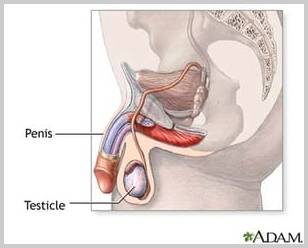
Hydrocele
A hydrocele is a fluid-filled sac surrounding the testicle that results in swelling in the scrotum or groin. It is common in newborn babies and usually disappears during the first year. It is possible to develop a hydrocele in older boys or men as a result of inflammation or injury. Between 1-2 percent of male infants have this problem and babies born prematurely are at increased risk. Hydroceles in adult men most often develop in men older than 40 years of age. Risk factors associated with hydrocele in adults include scrotal injury and infections, including sexually transmitted ones. It is important to get any scrotal swelling evaluate to rule out conditions such as hernia, testicular torsion or testicular cancer. If a hydrocele is large enough or does not resolve, it may be recommended to have surgical removal.
Causes of Hydrocele
Hydroceles are most often the result of incomplete prenatal development. There is a sac within each testicle which allows fluid to surround the testicle. The sac usually closes and the fluid is absorbed. Hydroceles are classified as either communicating or non-communicating. When the fluid remains after closure of the sac, this is a non-communicating hydrocele. A communicating hydrocele is when the sac remains open which allow fluid to move back to the abdomen. Communicating hydroceles are associated with inguinal hernias.
In older boys or adult men, hydroceles may appear due to:
- Injury to or surgery of the groin or scrotum
- Inflammation or infection of the testicles or epididymis
- Cancer of the testicle or of the left kidney
- Idiopathic (unknown)
Symptoms of a Hydrocele
Hydrocele are generally asymptomatic. Men may experience a painless swelling, “heaviness” or “pulling” of the scrotum. The larger the swelling, the more likely the man is to experience discomfort. At times, the swelling may increase as the day goes on, but in many cases, it may disappear on its own within 6 months.
Diagnosis of a Hydrocele
A thorough physical examination is completed. The patient is checked for tenderness and swelling in the scrotum. A patient is also evaluated for the presence of an inguinal hernia. A hydrocele can be evaluated through transillumination (shining a light on the testicle), for the presence of clear fluid around the testicle. Other tests may also be taken to test for possible infection, and ultrasound or CT scan to rule out a hernia or a testicular tumor and to confirm the diagnosis.
Treatment of a Hydrocele
Hydroceles are generally removed in adults if they cause discomfort or if they become very large and bothersome. The surgical procedure is called a hydrocelectomy. It is an outpatient procedure under general or local anesthesia where an incision is made and the hydrocele sac is removed. There is no guarantee that the hydrocele will not reform, but the procedure is effective at getting rid of hydrocele. Needle aspiration involves using a needle to drain excess fluid from the hydrocele. It is not as effective as hydrocelectomy and is most effective when there is an injection of a sclerosing agent in order to prevent the refilling of the sac. Aspiration alone only provides temporary relief and each repeated aspiration increases the chance of infection.
Recovery from a Hydrocelectomy
After the surgery, patients may have a drainage tube and bulky dressing for a few days. It is important to be on bed rest and avoid strenuous activity. Applying ice packs and wearing a scrotal support strap immediately after the procedure may be advised to decrease discomfort. Typically, the patient is fully recovered and back to normal activities a week or two after treatment, though some swelling may be visible for up to a couple of months. Since there is a possibility that a hydrocele may recur, it is important to continue to followup with your provider.
Complications of a Hydrocele
A hydrocele is not generally a serious problem and it doesn't normally affect male fertility. It is only problematic when it is associated with an infection, a tumor, or an inguinal hernia. A serious infection or tumor can possibly reduce sperm production or sexual function and an inguinal hernia can, left untreated, lead to life-threatening complications.
